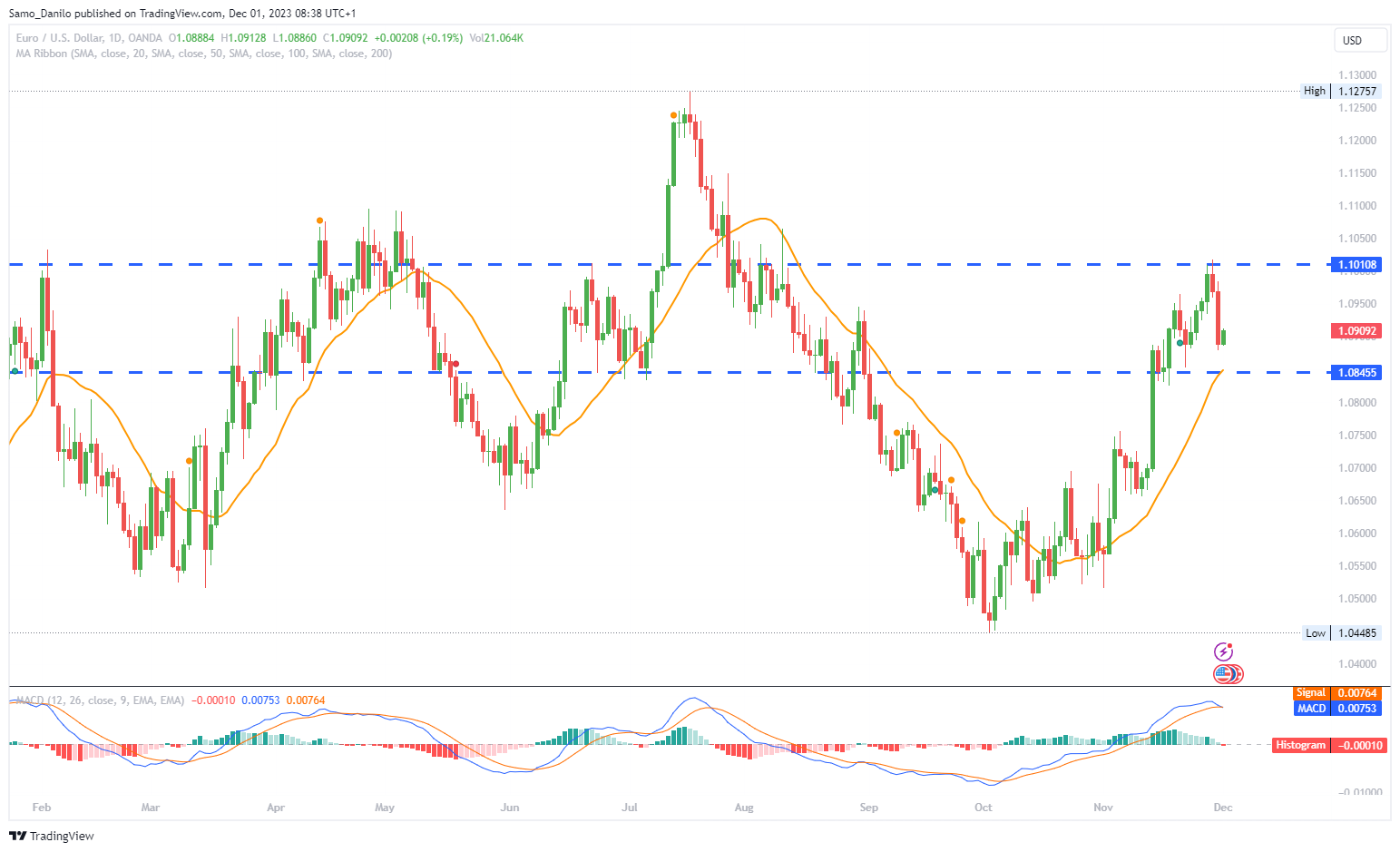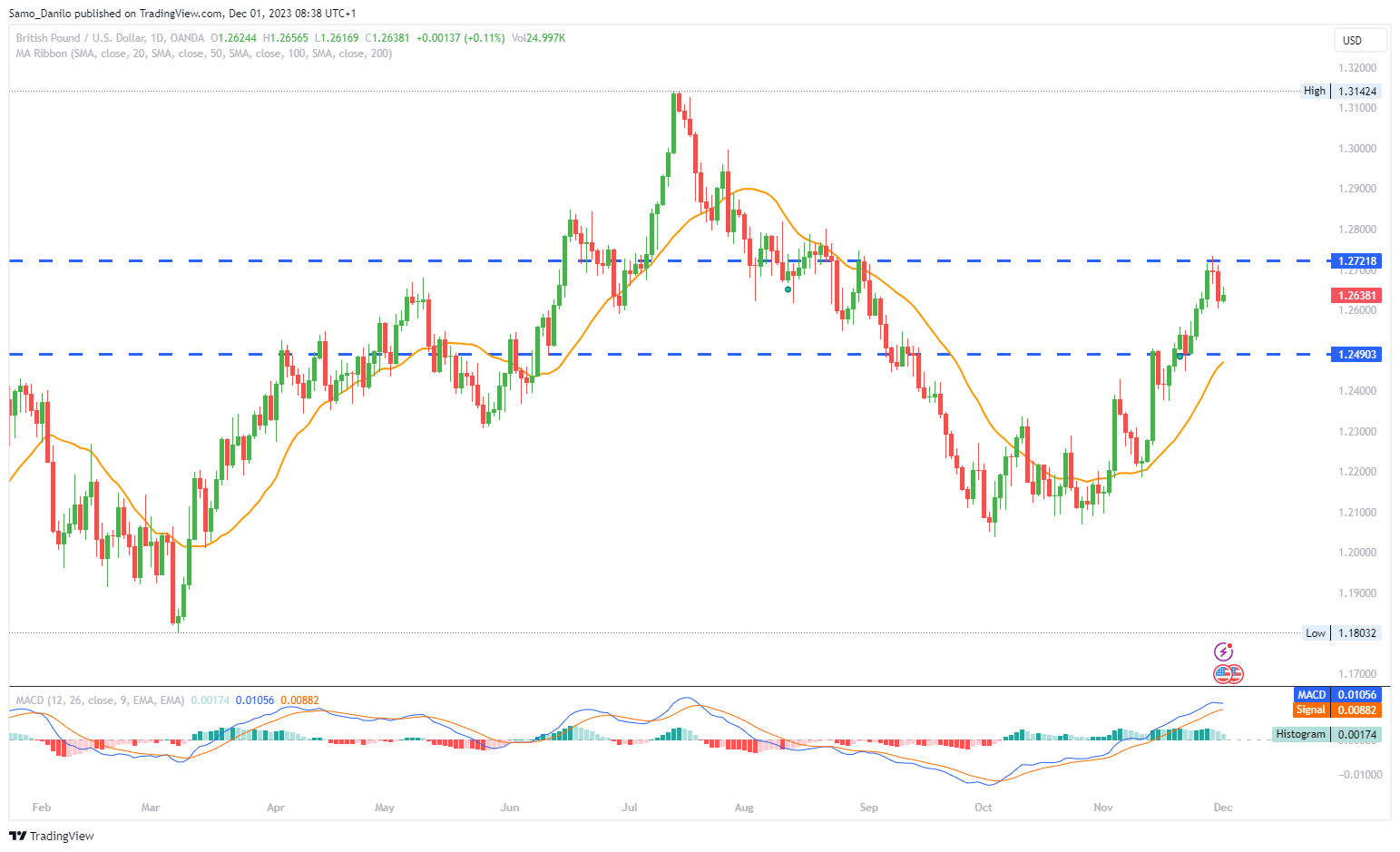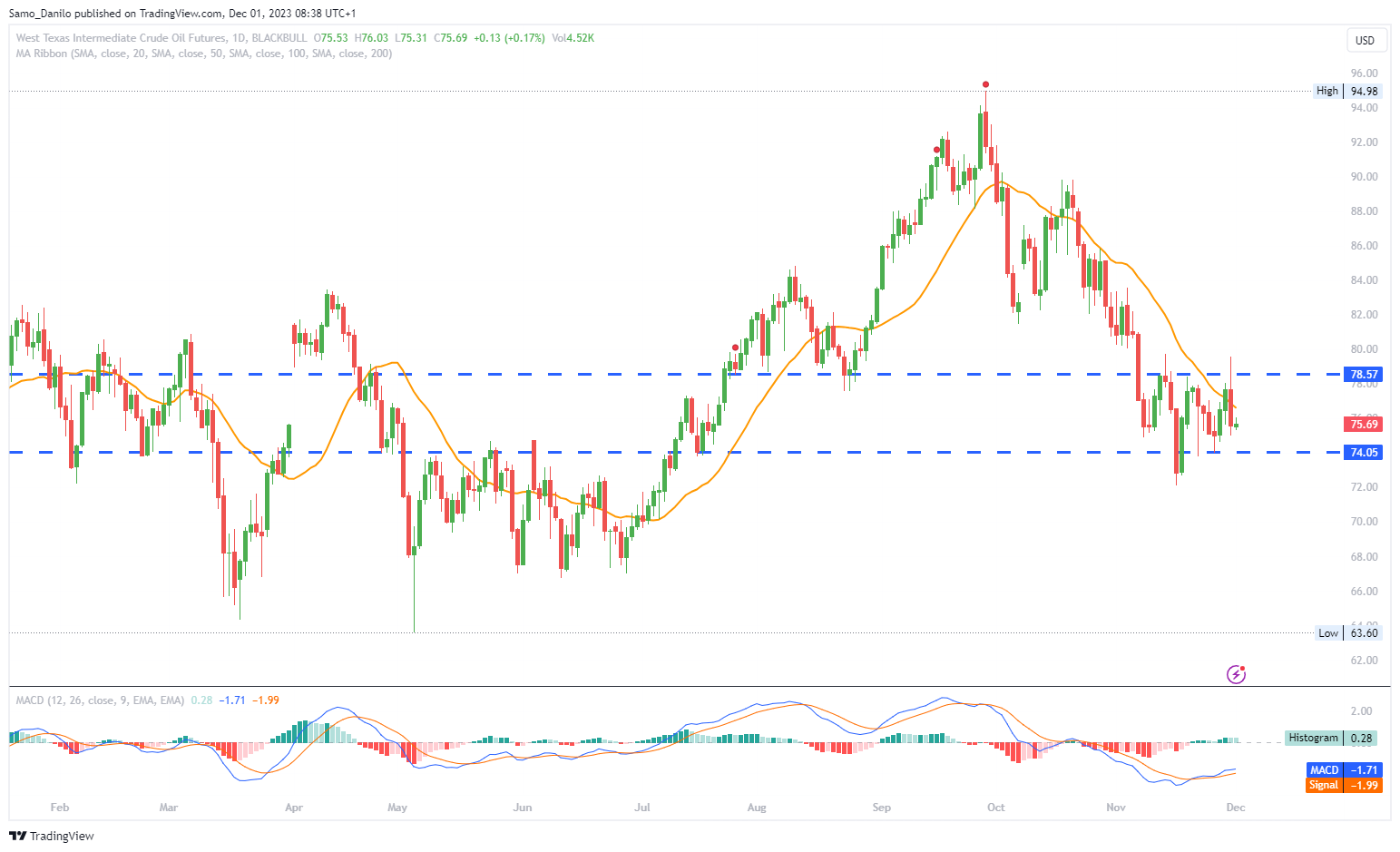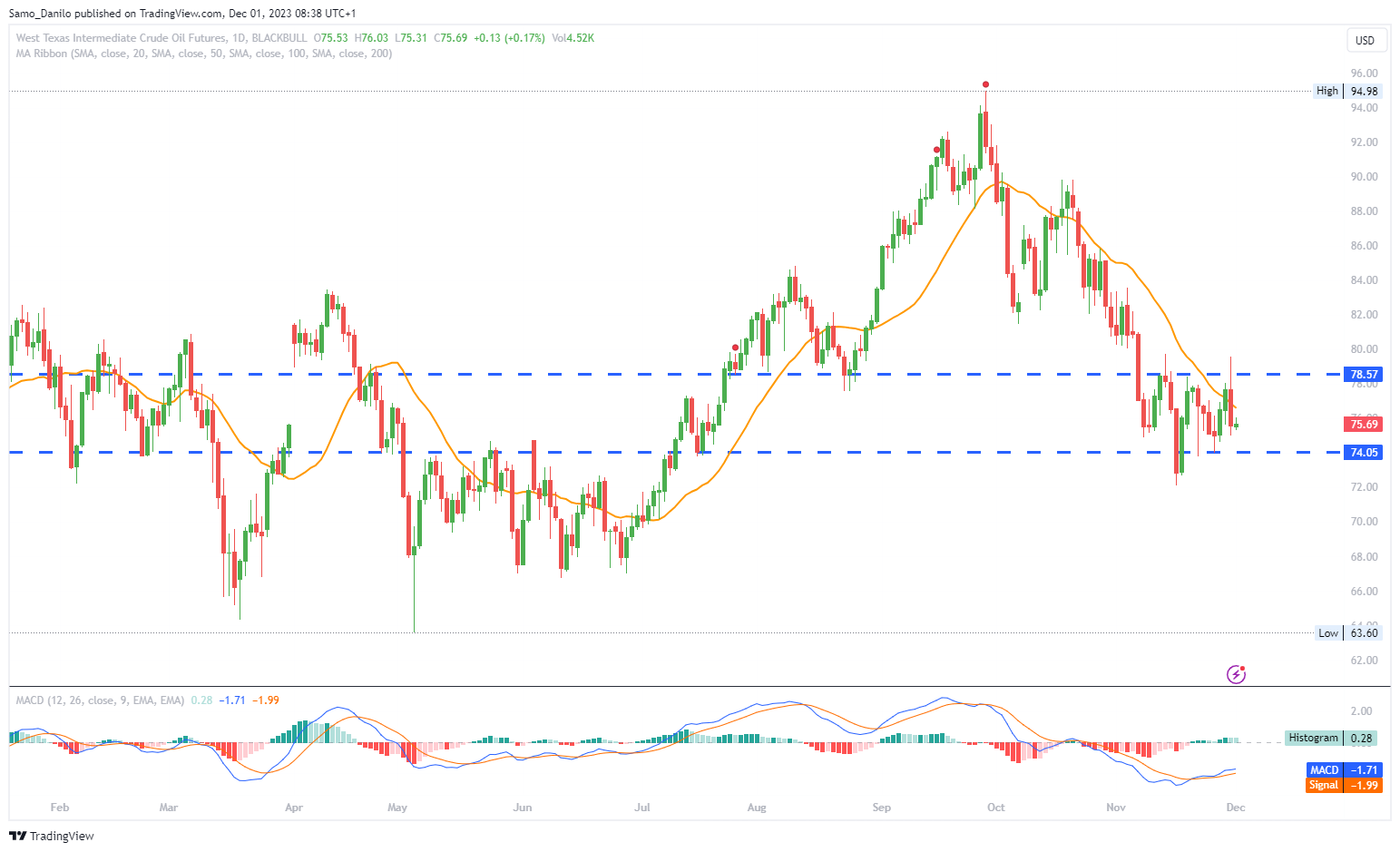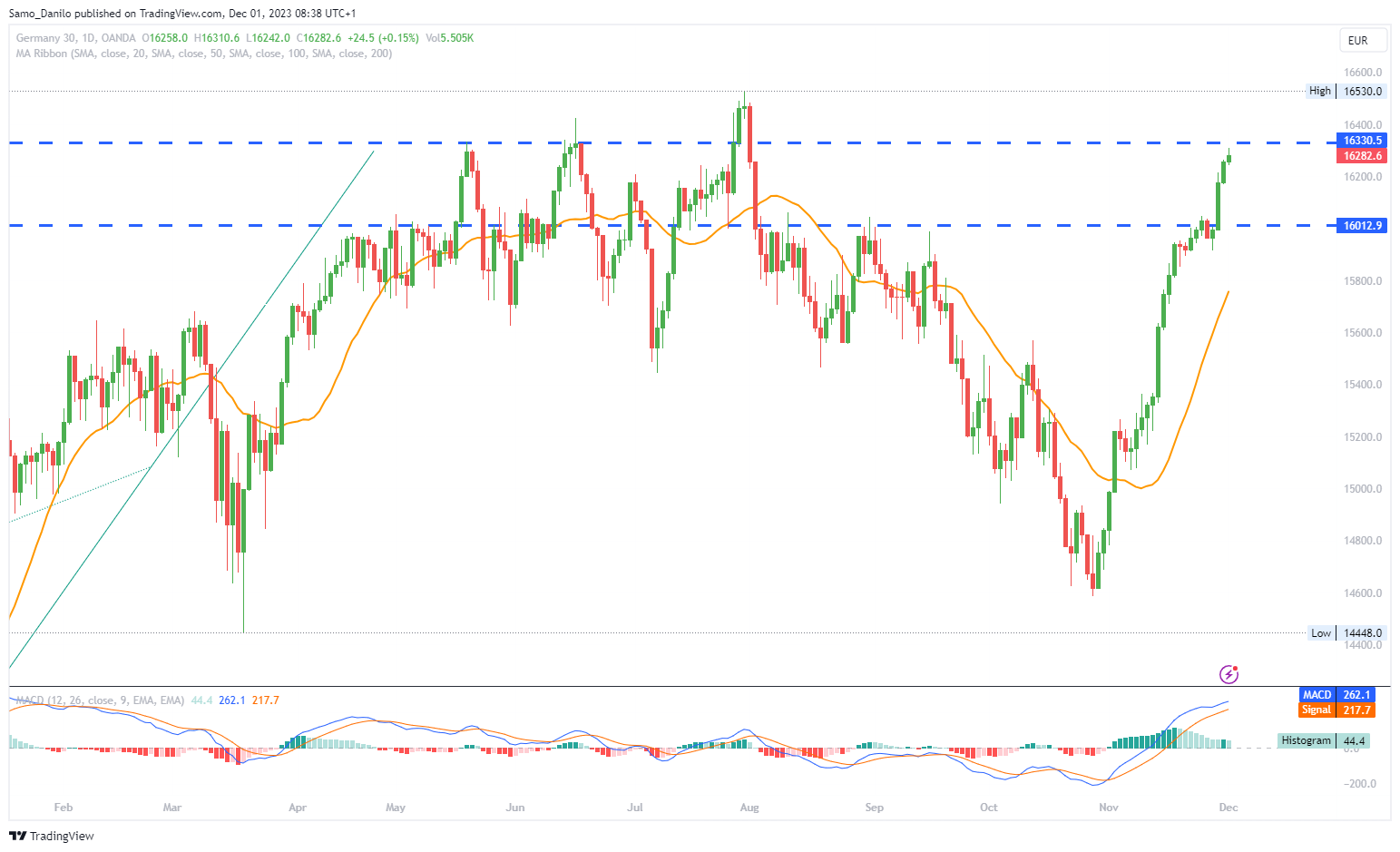EURUSD
- The EUR/USD pair experienced a retracement from its recent high of 1.1017, settling around the psychological mark of 1.0900 during Asian trading on Friday.
- Eurozone Consumer Price Index (CPI) data for November reveals a year-on-year increase of 2.4%, a decline from October's 2.9%. The Core rate also decreased to 3.6% from 4.2%, signaling potential easing of inflationary pressures.
- With inflation approaching the ECB's 2% target, there is speculation in the market about the possibility of the ECB refraining from further rate hikes and discussions about the timing of the first rate cut.
- Despite risk appetite, the US Dollar strengthened, supported by a rebound in US Treasury yields, indicating a preference for the greenback amid global economic uncertainties.
- Continuing Jobless Claims in the US reached their highest level since November 2021., underscoring challenges in the labor market and potentially impacting the overall economic outlook.
Closing statement: The EUR/USD pair faced a retracement, influenced by Eurozone CPI data reflecting a slight easing in inflation. Market focus is on ECB actions, as speculations arise about a potential shift in monetary policy. The strengthening US Dollar, driven by higher Treasury yields, adds complexity, while concerns in the US labour market may impact broader economic sentiments. The upcoming release of the ISM Manufacturing PMI in the US adds further variables to consider.
GBPUSD
- GBP/USD has rebounded, recovering from previous losses, and is trading higher around 1.2650 during the Asian session on Friday.
- The US Dollar witnessed a decline, triggered by unexpectedly dovish comments from Federal Reserve (Fed) officials, reinforcing the market sentiment that the era of rate hikes may be over.
- Bank of England (BoE) officials have conveyed hawkish signals, contributing to the strength of the Pound Sterling (GBP) in the market.
- There is an expectation that the BoE will maintain higher interest rates for an extended period, especially given that the current inflation rate is more than twice the central bank's target.
- BoE interest rate-setter Megan Greene expressed concerns about persistently high inflation, suggesting that elevated interest rates might be necessary for a prolonged duration.
| SMA (20) | Rising |
|
|
| RSI (14) | Slightly Falling |
| |
| MACD (12, 26, 9) | Slightly Rising |
|
Closing statement: GBP/USD showcases a recovery, supported by a weaker US Dollar amid unexpected dovish signals from the Fed. The Bank of England's hawkish stance and concerns about high inflation reinforce the expectation of sustained higher interest rates, shaping the currency pair's dynamics. As uncertainties persist, monitoring further developments in central bank policies will be crucial.
GOLD
- Gold returned to positive territory early on Friday, recovering from a corrective decline after reaching six-month highs of $2,052 on Thursday.
- The soft reading of the US Core Personal Consumption Expenditures (PCE) Price Index data has strengthened dovish expectations regarding the Federal Reserve's (Fed) monetary policy.
- The Core PCE Price Index, a key inflation metric, rose at an annual pace of 3.0% in October, showing moderation from the previous three-month readings of 3.4% but still above the Fed's 2% target.
- Comments from New York Fed Bank President John Williams and San Francisco Fed President Mary Daly suggested a cautious stance. Williams indicated a peak in the federal funds rate, while Daly's "base case" doesn't foresee further rate hikes, though it's uncertain if the Fed is done with increases.
- Attention is turning to the US ISM Manufacturing PMI data and Federal Reserve Chair Jerome Powell’s scheduled appearances later in the day for further insights into economic conditions and the Fed's outlook.
| SMA (20) | Rising |
|
|
| RSI (14) | Rising |
|
|
| MACD (12, 26, 9) | Rising |
|
|
Closing statement: Gold's rebound is influenced by dovish Fed expectations, especially after the release of softer Core PCE data. Comments from Fed officials underline a cautious approach, impacting gold prices. Investors are now keenly awaiting the US ISM Manufacturing PMI and insights from Fed Chair Jerome Powell for potential market direction.
CRUDE OIL
- West Texas Intermediate (WTI) crude oil has rebounded, trading higher around $75.90 per barrel, marking a recovery from recent losses.
- The Organization of the Petroleum Exporting Countries and its allies (OPEC+) decided to implement voluntary output cuts for the first quarter of 2024. The announced total reduction is 2.2 million barrels per day (bpd) from eight producers.
- Saudi Arabia and Russia have committed to extending voluntary cuts, contributing 1.3 million bpd. Russia, additionally, pledged 200,000 bpd in fuel export reductions, and six other member countries will collectively make up the remaining 900,000 bpd of cuts.
- Weak Purchasing Managers Index (PMI) data from China intensified pressure on oil markets, reflecting minimal signs of improvement in business activity in November. However, Manufacturing PMI in November showed improvement on Friday.
- The US Energy Information Administration (EIA) reported a crude oil stock change of 1.609 million barrels for the week ending on November 24, contrasting with the expected deficit of 0.933 million barrels.
- WTI's rebound is influenced by OPEC+ decisions on output cuts for 2024. The commitment of major producers, including Saudi Arabia and Russia, has contributed to market stability. However, the impact of China's economic data and the unexpected increase in US crude stocks add complexity to the oil market dynamics.
| SMA (20) | Falling |
|
|
| RSI (14) | Neutral | ||
| MACD (12, 26, 9) | Slightly Rising |
|
Closing statement: WTI's rebound is influenced by OPEC+ decisions on output cuts for 2024. The commitment of major producers, including Saudi Arabia and Russia, has contributed to market stability. However, the impact of China's economic data and the unexpected increase in US crude stocks add complexity to the oil market dynamics.
DAX
- Eurozone inflation figures on Thursday raised expectations of the European Central Bank (ECB) cutting rates in H1 2024. The annual core inflation rate softened from 4.2% to 3.6% in November.
- Despite disappointing German unemployment and French GDP numbers, investors largely focused on Eurozone inflation. The heavily anticipated US inflation and personal income/spending data were DAX-friendly as inflation softened in November.
- On Friday, investor attention will shift to Eurozone manufacturing sector PMIs. As bets on an H1 2024 ECB rate cut rise, the focus may return to the euro area economy, particularly the manufacturing sector.
- With the manufacturing sector in focus, ECB commentary gains significance. ECB President Christine Lagarde is scheduled to speak, and her comments regarding inflation numbers and interest rates will be crucial in influencing market sentiment.
- The DAX appears sensitive to inflation dynamics, both in the Eurozone and the US, and investors are closely monitoring central bank commentary for insights into future monetary policy decisions.
| SMA (20) | Rising |
|
|
| RSI (14) | Rising |
|
|
| MACD (12, 26, 9) | Rising |
|
|
Closing statement: The DAX's performance is intricately linked to inflation trends, with Eurozone figures influencing expectations of an ECB rate cut. As attention turns to manufacturing PMIs and ECB commentary, investors seek insights into the economic outlook and potential policy moves.
